






A broken ankle can cause severe pain and discomfort. It generally occurs from a fall and can affect one or several bones in the ankle. Some patients can hear the bone break at the time of the injury and this may sound like a grinding or snapping noise. Common symptoms can include swelling or bruising, and it is often difficult to walk. In severe fractures, the bone may protrude from the skin and appear deformed. It is important to have an X-ray performed which can determine the severity of the fracture. Relief may be found when keeping weight off of the affected foot and frequently elevating the foot may also reduce existing swelling. Many broken ankles are treated by wearing a cast or a boot. This is effective in keeping the ankle stable as healing takes place. It may be easier to walk when crutches are used. If you have broken your ankle, please consult a podiatrist immediately who can properly diagnose your condition and offer treatment options which may include surgery for severe breaks.
Broken ankles need immediate treatment. If you are seeking treatment, contact one of our podiatrists from Active Foot and Ankle Care, LLC. Our doctors can provide the care you need to keep you pain-free and on your feet.
Broken Ankles
A broken ankle is experienced when a person fractures their tibia or fibula in the lower leg and ankle area. Both of these bones are attached at the bottom of the leg and combine to form what we know to be our ankle.
When a physician is referring to a break of the ankle, he or she is usually referring to a break in the area where the tibia and fibula are joined to create our ankle joint. Ankles are more prone to fractures because the ankle is an area that suffers a lot of pressure and stress. There are some obvious signs when a person experiences a fractured ankle, and the following symptoms may be present.
Symptoms of a Fractured Ankle
If you suspect an ankle fracture, it is recommended to seek treatment as soon as possible. The sooner you have your podiatrist diagnose the fracture, the quicker you’ll be on the way towards recovery.
If you have any questions, please feel free to contact our offices located in Fair Lawn, Riverdale, and Englewood, NJ . We offer the newest diagnostic and treatment technologies for all your foot care needs.
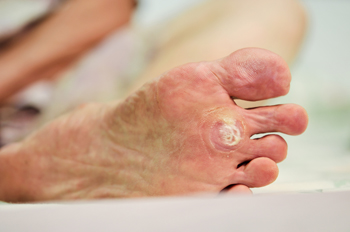
Research has shown that plantar warts affect approximately ten percent of the population. They are warts that develop on the sole of the foot, and grow inward as a result of the weight the feet endure on a daily basis. They are generally caused by the human papilloma virus (HPV), and can enter the body through small cuts in the skin on the feet. They are prone to developing on the ball and heel of the foot, and are considered to be hyperkeratotic eruptions. Plantar warts can cause severe pain and discomfort, and aggressive treatment may be necessary to relieve the pain while walking. Some patients have to alter their style of walking if they have a plantar wart, and their posture may be affected. If you have a wart on the bottom of your foot, please seek the counsel of a podiatrist who can effectively treat this condition.
Plantar warts can be very uncomfortable. If you need your feet checked, contact one of our podiatrists from Active Foot and Ankle Care, LLC. Our doctors will assist you with all of your foot and ankle needs.
About Plantar Warts
Plantar warts are the result of HPV, or human papillomavirus, getting into open wounds on the feet. They are mostly found on the heels or balls of the feet.
While plantar warts are generally harmless, those experiencing excessive pain or those suffering from diabetes or a compromised immune system require immediate medical care. Plantar warts are easily diagnosed, usually through scraping off a bit of rough skin or by getting a biopsy.
Symptoms
Treatment
To help prevent developing plantar warts, avoid walking barefoot over abrasive surfaces that can cause cuts or wounds for HPV to get into. Avoiding direct contact with other warts, as well as not picking or rubbing existing warts, can help prevent the further spread of plantar warts. However, if you think you have developed plantar warts, speak to your podiatrist. He or she can diagnose the warts on your feet and recommend the appropriate treatment options.
If you have any questions please feel free to contact our offices located in Fair Lawn, Riverdale, and Englewood, NJ . We offer the newest diagnostic and treatment technologies for all your foot and ankle needs.
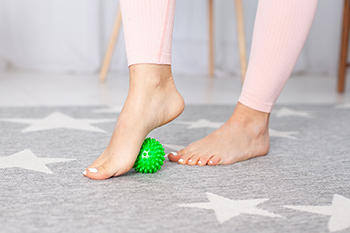
Many forms of exercise target the larger muscle groups, and the small muscles in the feet may be overlooked. Research has shown that when the ball of the foot is properly stretched, the overall foot may become stronger by improving arch and surrounding ligaments. An effective stretch is referred to as the golf ball stretch. This is done by rolling the sole of the foot over a golf ball for several minutes, then switching feet. Many people find it beneficial to walk on their tip toes, and this can help to build up the balls of the feet. Additionally, calf raises can be done with resistance as the strength in the feet increases. Having a full range of motion in your feet is essential in keeping the feet strong. This can be practiced by standing on a stool while dangling the legs. The big toe can be used as an imaginary pencil, and letters of the alphabet can be drawn with the toes. If you would like additional information about how exercise can benefit the feet, please contact a podiatrist who can provide useful information.
Exercising your feet regularly with the proper foot wear is a great way to prevent injuries and build strength. If you have any concerns about your feet, contact one of our podiatrists from Active Foot and Ankle Care, LLC. Our doctors can provide the care you need to keep you pain-free and on your feet.
Exercise for Your Feet
Exercise for your feet can help you gain strength, mobility and flexibility in your feet. They say that strengthening your feet can be just as rewarding as strengthening another part of the body. Your feet are very important, and we often forget about them in our daily tasks. But it is because of our feet that are we able to get going and do what we need to. For those of us fortunate enough to not have any foot problems, it is an important gesture to take care of them to ensure good health in the long run.
Some foot health exercises can include ankle pumps, tip-toeing, toe rises, lifting off the floor doing reps and sets, and flexing the toes. It is best to speak with Our doctors to determine an appropriate regimen for your needs. Everyone’s needs and bodies are different, and the activities required to maintain strength in the feet vary from individual to individual.
Once you get into a routine of doing regular exercise, you may notice a difference in your feet and how strong they may become.
If you have any questions please feel free to contact our offices located in Fair Lawn, Riverdale, and Englewood, NJ . We offer the newest diagnostic and treatment technologies for all your foot and ankle needs.
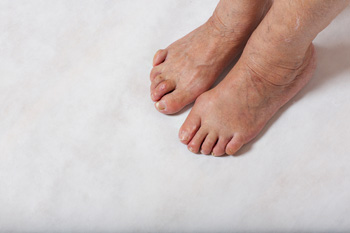
The foot condition that is known as hammertoe is considered to be a deformity. It is a noticeable ailment that affects the toes, and can resemble a hammer. The middle joint of the second toe bends downward, and corns may form on top of the affected joint. The toes are made of muscles, bones, joints, tendons, and ligaments. These vital parts of the toe work together to bend and straighten the toes, and hammertoe can develop if there is an imbalance in the toe structure. It can come from wearing shoes that do not have adequate room for the toes to move freely in, or from shoes that are too tight. Wearing the wrong footwear can squeeze the toes into a bent position. There are some patients who may be prone to developing this deformity that have existing medical conditions including flat feet, or longer toe bones. Relief may be found when specific stretches are practiced, including toe flexion and extension, and performing a foam roll massage. If you have been afflicted with hammertoe, please confer with a podiatrist who can determine the severity of this condition, and recommend correct treatment options.
Hammertoe
Hammertoes can be a painful condition to live with. For more information, contact one of our podiatrists from Active Foot and Ankle Care, LLC. Our doctors will answer any of your foot- and ankle-related questions.
Hammertoe is a foot deformity that affects the joints of the second, third, fourth, or fifth toes of your feet. It is a painful foot condition in which these toes curl and arch up, which can often lead to pain when wearing footwear.
Symptoms
Causes
Genetics – People who are genetically predisposed to hammertoe are often more susceptible
Arthritis – Because arthritis affects the joints in your toes, further deformities stemming from arthritis can occur
Trauma – Direct trauma to the toes could potentially lead to hammertoe
Ill-fitting shoes – Undue pressure on the front of the toes from ill-fitting shoes can potentially lead to the development of hammertoe
Treatment
Orthotics – Custom made inserts can be used to help relieve pressure placed on the toes and therefore relieve some of the pain associated with it
Medications – Oral medications such as anti-inflammatories or NSAIDs could be used to treat the pain and inflammation hammertoes causes. Injections of corticosteroids are also sometimes used
Surgery – In more severe cases where the hammertoes have become more rigid, foot surgery is a potential option
If you have any questions please contact our offices located in Fair Lawn, Riverdale, and Englewood, NJ . We offer the newest diagnostic and treatment technologies for all your foot and ankle needs.
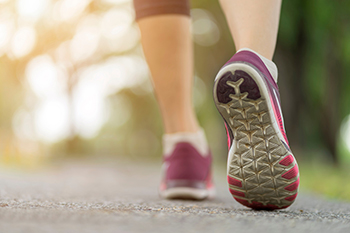
Walking is an activity that as soon as we learn how to do it, we take it for granted. However, sometimes walking can become difficult because of age, illness, injury, or other factors. Symptoms that may develop are shooting pain, numbness and tingling, stiffness, imbalance, weakness, and limping. Types of gait abnormalities include walking with your head and neck pushed forward, walking with legs bent inward, dragging the feet while walking, waddling from side to side, and toes scraping the ground with each step. Among the many causes that can affect your gait are nerve damage, improper alignment of the body, lack of muscle strength and flexibility, inflammatory diseases and conditions, autoimmune deficiencies, injury, and stroke. If you notice an increased difficulty walking and are experiencing any of the symptoms listed above, please consult a podiatrist who can conduct a complete examination and offer an appropriate treatment plan.
If you have any concerns about your feet, contact one of our podiatrists from Active Foot and Ankle Care, LLC. Our doctors can provide the care you need to keep you pain-free and on your feet.
Biomechanics in Podiatry
Podiatric biomechanics is a particular sector of specialty podiatry with licensed practitioners who are trained to diagnose and treat conditions affecting the foot, ankle and lower leg. Biomechanics deals with the forces that act against the body, causing an interference with the biological structures. It focuses on the movement of the ankle, the foot and the forces that interact with them.
A History of Biomechanics
Modern technological improvements are based on past theories and therapeutic processes that provide a better understanding of podiatric concepts for biomechanics. Computers can provide accurate information about the forces and patterns of the feet and lower legs.
Understanding biomechanics of the feet can help improve and eliminate pain, stopping further stress to the foot.
If you have any questions please feel free to contact our offices located in Fair Lawn, Riverdale, and Englewood, NJ . We offer the newest diagnostic and treatment technologies for all your foot and ankle needs.

The heel condition that is referred to as Sever’s disease generally affects children and young teenagers who are involved in sporting activities. The heel can often feel sore when Sever’s disease is present, and it may be difficult to walk. It is defined as a condition that affects the growth plate in the heel, and can be confirmed by having a physical examination performed. Relief is often found when the activity that caused the condition is stopped, and the heel is frequently rested. It is important to practice specific stretches once the heel feels better, and this may help to accelerate the recovery process. Many patients choose to wear a heel cushion in their shoe which may be able to provide additional padding. If your child is affected by Sever’s disease, it is advised that a podiatrist be consulted for proper prevention and healing tips.
Sever's disease often occurs in children and teens. If your child is experiencing foot or ankle pain, see one of our podiatrists from Active Foot and Ankle Care, LLC. Our doctors can treat your child’s foot and ankle needs.
Sever’s Disease
Sever’s disease is also known as calcaneal apophysitis, which is a medical condition that causes heel pain I none or both feet. The disease is known to affect children between the ages of 8 and 14.
Sever’s disease occurs when part of the child’s heel known as the growth plate (calcaneal epiphysis) is attached to the Achilles tendon. This area can suffer injury when the muscles and tendons of the growing foot do not keep pace with bone growth. Therefore, the constant pain which one experiences at the back of the heel will make the child unable to put any weight on the heel. The child is then forced to walk on their toes.
Symptoms
Acute pain – Pain associated with Sever’s disease is usually felt in the heel when the child engages in physical activity such as walking, jumping and or running.
Highly active – Children who are very active are among the most susceptible in experiencing Sever’s disease, because of the stress and tension placed on their feet.
If you have any questions, please feel free to contact our offices located in Fair Lawn, Riverdale, and Englewood, NJ . We offer the newest diagnostic and treatment technologies for all your foot and ankle injuries.
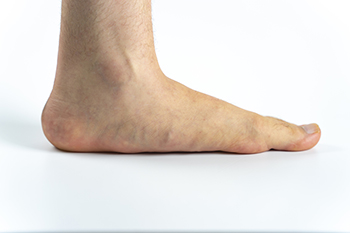
Flat feet is generally easy to notice when one is barefoot. While standing flat on the floor, a person that has flat feet will have a small or absent arch, which causes the foot to lie completely flat on the floor. There are some patients who are pregnant or overweight and will develop flat feet temporarily. When their condition changes, the feet will resume their arch. People who enjoy running may experience conditions throughout their bodies that may be related to having flat feet. Flat feet can cause over-pronation, which is when the feet roll inward. It can be a common condition among runners, and it is beneficial to maintain a healthy weight which can lessen the pressure on the feet. Additionally, it is important to follow a good training practice, which may prevent overuse injuries. If you have flat feet, it is suggested that you are under the care of a podiatrist who can prescribe custom made orthotics or shoe inserts specifically designed to your feet.
Flatfoot is a condition many people suffer from. If you have flat feet, contact one of our podiatrists from Active Foot and Ankle Care, LLC. Our doctors will treat your foot and ankle needs.
What Are Flat Feet?
Flatfoot is a condition in which the arch of the foot is depressed and the sole of the foot is almost completely in contact with the ground. About 20-30% of the population generally has flat feet because their arches never formed during growth.
Conditions & Problems:
Having flat feet makes it difficult to run or walk because of the stress placed on the ankles.
Alignment – The general alignment of your legs can be disrupted, because the ankles move inward which can cause major discomfort.
Knees – If you have complications with your knees, flat feet can be a contributor to arthritis in that area.
Symptoms
Treatment
If you are experiencing pain and stress on the foot you may weaken the posterior tibial tendon, which runs around the inside of the ankle.
If you have any questions please feel free to contact our offices located in Fair Lawn, Riverdale, and Englewood, NJ . We offer the newest diagnostic and treatment technologies for all your foot and ankle needs.

A doctor who specializes in foot care is known as a podiatrist. There are several reasons why patients visit podiatrists, including having conditions such as hammertoes, bunions, and plantar fasciitis. Research has shown that the feet often show early signs of other conditions that may be present in the body, which may include diabetes and heart disease. People who choose to pursue this field of medicine as a career will need to obtain a bachelor’s degree, followed by attending a podiatry school for four years. A residency is then completed, which precedes obtaining a license. Podiatrists can work in a private or group practice or specialize in specific areas which can include sports medicine and diabetic foot care. If you are considering a career in podiatry, it is beneficial to speak with a podiatrist who can help you to determine if this is the right choice for you.
If you are experiencing pain in the feet or ankles, don’t join the stubborn majority refusing treatment. Feel free to contact one of our podiatrists from Active Foot and Ankle Care, LLC. Our doctors can provide the care you need to keep you pain-free and on your feet.
What Is a Podiatrist?
Someone would seek the care of a podiatrist if they have suffered a foot injury or have common foot ailments such as heal spurs, bunions, arch problems, deformities, ingrown toenails, corns, foot and ankle problems, etc.
Podiatric Treatment
A podiatrist will treat the problematic areas of the feet, ankle or lower leg by prescribing the following:
A common podiatric procedure a podiatrist will use is a scanner or force plate which will allow the podiatrist to know the designs of orthotics. Patients are then told to follow a series of tasks to complete the treatment. The computer will scan the foot a see which areas show weight distribution and pressure points. The podiatrist will read the analysis and then determine which treatment plans are available.
If you have any questions please feel free to contact our offices located in Fair Lawn, Riverdale, and Englewood, NJ . We offer the newest diagnostic and treatment technologies for all your foot and ankle needs.
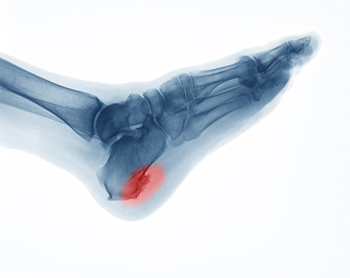
Research has shown that for every mile walked, there are sixty tons of stress that goes through the foot. Heel pain can indicate a heel spur may have developed and can become worse without proper treatment. It is defined as a bony growth that forms at the base of the heel and can cause severe pain and discomfort. This condition can come from standing on your feet for most of the day, or from wearing shoes that do not fit correctly. Some patients find it helpful to practice specific stretching exercises, and this may help them to find mild relief. Additionally, when proper stretches are performed, it may give the foot the ability to have increased range of motion and flexibility. Obese patients may find it beneficial to lose extra pounds and wearing heel pads may provide temporary relief from the heel spur. If you have developed this ailment, it is suggested that you are under the care of a podiatrist who can properly treat heel spurs.
Heel spurs can be incredibly painful and sometimes may make you unable to participate in physical activities. To get medical care for your heel spurs, contact one of our podiatrists from Active Foot and Ankle Care, LLC. Our doctors will do everything possible to treat your condition.
Heels Spurs
Heel spurs are formed by calcium deposits on the back of the foot where the heel is. This can also be caused by small fragments of bone breaking off one section of the foot, attaching onto the back of the foot. Heel spurs can also be bone growth on the back of the foot and may grow in the direction of the arch of the foot.
Older individuals usually suffer from heel spurs and pain sometimes intensifies with age. One of the main condition's spurs are related to is plantar fasciitis.
Pain
The pain associated with spurs is often because of weight placed on the feet. When someone is walking, their entire weight is concentrated on the feet. Bone spurs then have the tendency to affect other bones and tissues around the foot. As the pain continues, the feet will become tender and sensitive over time.
Treatments
There are many ways to treat heel spurs. If one is suffering from heel spurs in conjunction with pain, there are several methods for healing. Medication, surgery, and herbal care are some options.
If you have any questions feel free to contact our offices located in Fair Lawn, Riverdale, and Englewood, NJ . We offer the latest in diagnostic and treatment technology to meet your needs.
 Many people with diabetes, especially those over 55 years old, develop a condition known as peripheral neuropathy. It affects nerves in the outer portion of the body, rather than in the heart and central core. A common symptom of peripheral neuropathy is a feeling of pins and needles, combined with shooting pain in the feet. You may also feel a loss of balance, lack of coordination, and muscle weakness. In addition, neuropathy may also cause sores on your feet to take a long time to heal. Diabetes is thought to be a major cause of peripheral neuropathy, the result of continual high blood sugar levels that damage the nerves. Other causes include direct injury to the nerves, a viral infection (such as shingles), a side-effect of some medications, smoking, and drinking too much alcohol. If you have diabetes or are experiencing any of the above symptoms, it is a good idea to develop an ongoing relationship with a podiatrist for a diagnosis, continued monitoring, and treatment specific to your case.
Many people with diabetes, especially those over 55 years old, develop a condition known as peripheral neuropathy. It affects nerves in the outer portion of the body, rather than in the heart and central core. A common symptom of peripheral neuropathy is a feeling of pins and needles, combined with shooting pain in the feet. You may also feel a loss of balance, lack of coordination, and muscle weakness. In addition, neuropathy may also cause sores on your feet to take a long time to heal. Diabetes is thought to be a major cause of peripheral neuropathy, the result of continual high blood sugar levels that damage the nerves. Other causes include direct injury to the nerves, a viral infection (such as shingles), a side-effect of some medications, smoking, and drinking too much alcohol. If you have diabetes or are experiencing any of the above symptoms, it is a good idea to develop an ongoing relationship with a podiatrist for a diagnosis, continued monitoring, and treatment specific to your case.
Neuropathy
Neuropathy can be a potentially serious condition, especially if it is left undiagnosed. If you have any concerns that you may be experiencing nerve loss in your feet, consult with one of our podiatrists from Active Foot and Ankle Care, LLC. Our doctors will assess your condition and provide you with quality foot and ankle treatment for neuropathy.
What Is Neuropathy?
Neuropathy is a condition that leads to damage to the nerves in the body. Peripheral neuropathy, or neuropathy that affects your peripheral nervous system, usually occurs in the feet. Neuropathy can be triggered by a number of different causes. Such causes include diabetes, infections, cancers, disorders, and toxic substances.
Symptoms of Neuropathy Include:
Those with diabetes are at serious risk due to being unable to feel an ulcer on their feet. Diabetics usually also suffer from poor blood circulation. This can lead to the wound not healing, infections occurring, and the limb may have to be amputated.
Treatment
To treat neuropathy in the foot, podiatrists will first diagnose the cause of the neuropathy. Figuring out the underlying cause of the neuropathy will allow the podiatrist to prescribe the best treatment, whether it be caused by diabetes, toxic substance exposure, infection, etc. If the nerve has not died, then it’s possible that sensation may be able to return to the foot.
Pain medication may be issued for pain. Electrical nerve stimulation can be used to stimulate nerves. If the neuropathy is caused from pressure on the nerves, then surgery may be necessary.
If you have any questions, please feel free to contact our offices located in Fair Lawn, Riverdale, and Englewood, NJ . We offer the newest diagnostic and treatment technologies for all your foot care needs.






